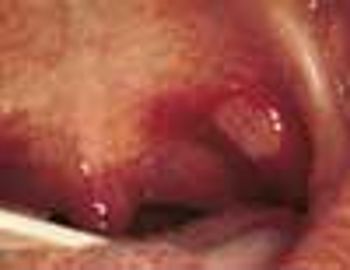
A patient arrives at your office complaining of severe pain associated with small lesions in his mouth. He tells you that similar painful sores had erupted in the past, but they healed and disappeared.

A patient arrives at your office complaining of severe pain associated with small lesions in his mouth. He tells you that similar painful sores had erupted in the past, but they healed and disappeared.
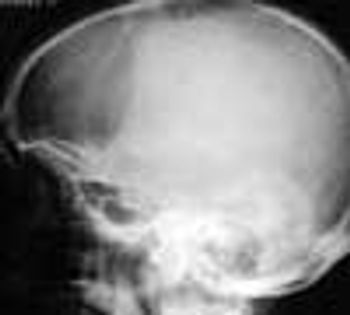
Skull x-ray films were taken after this 62-year-old nursing home resident fell and hit his head. The radiographs revealed only a sharply demarcated radiolucent area, mainly over the right parietal bone. Osteoporosis circumscripta was diagnosed.
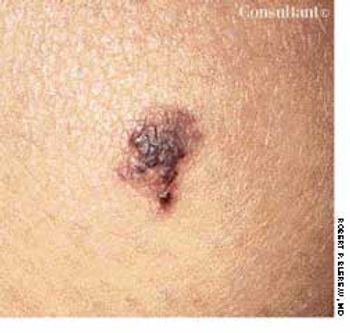
This lesion on her knee had been present for 5 years, reported a 22-year-old woman. It was not related to any trauma, and its size had not changed, but occasionally it became darker or lighter.
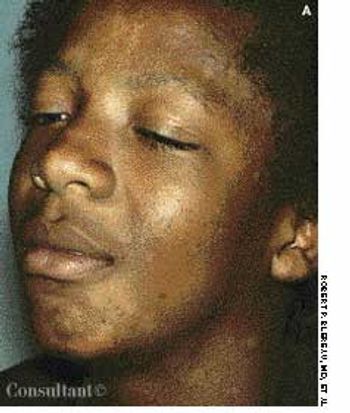
Although tinea versicolor is fairly common, its appearance on the face and neck is unusual, notes Robert P. Blereau, MD of Morgan City, La. His patient, a 30-year-old woman, exhibits the pale, rounded, fine-scaled lesions typically found on tanned or dark-skinned persons.
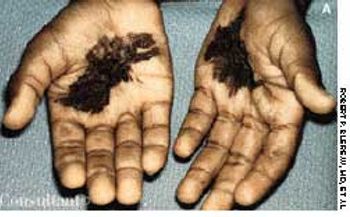
During a routine physical examination of a healthy 7-year-old African-American boy, this striking-and puzzling-hyperpigmentation was noted on his palms.
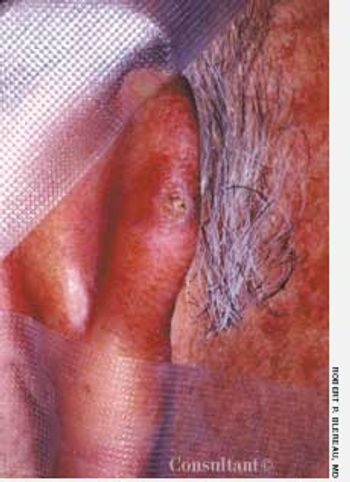
A 1-cm, tan-brown lesion had developed years earlier at the posterior helix of a 61-year-old man's right ear. Central ulceration and crusting were noted on the papule. The patient sought medical evaluation when the lesion became nodular and began to flake.

A 65-year-old woman presents with a 1-cm raised, light brown, circular, nodular lesion on the top of her head, which has progressively enlarged during the last 6 months.
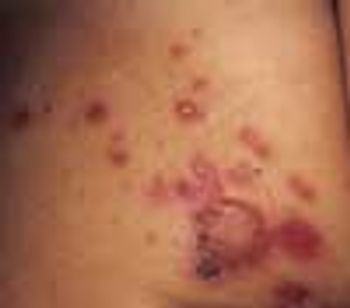
The numerous superficial, rounded, red-based ulcerations on the left buttock of a 3-year-old girl are characteristic of bullous impetigo. The varnish-like crust on the largest lesion is also typical of this skin infection.

A 55-year-old man claims that the clubbed appearance of his fingers had been present “as long as I can remember.” This patient has hereditary clubbing of the distal phalanges of all fingers; his toes are similarly affected.
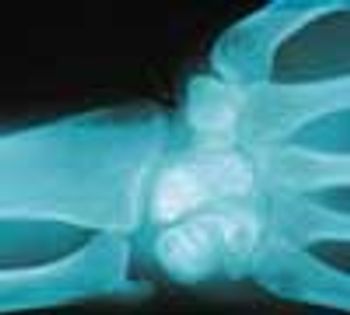
After a galley door slammed shut on his right wrist, a 37-year-old deckhand sought medical attention. He had no history of previous injury to the wrist. On examination, he had 50% of normal range of motion, and there was palpable tenderness and bony swelling at the dorsum of the wrist.
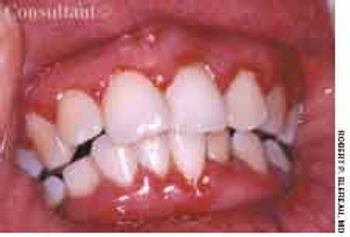
A 25-year-old primipara had her first prenatal visit at 12 weeks' gestation. She said that her gums had recently become irritated and bled easily.
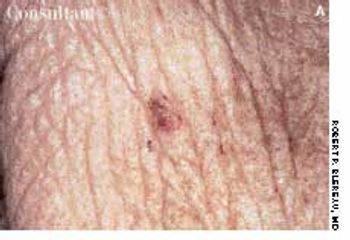
n asymptomatic pink lesion measuring approximately 1 cm in diameter appeared on this 80-year-old woman's right cheek 3 weeks before this picture was taken.
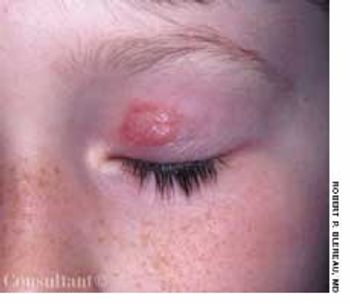
This 7-year-old presented with a pink, raised lesion on her upper left eyelid. The 1-cm lesion contained tiny vesicles and showed eccentric central clearing.
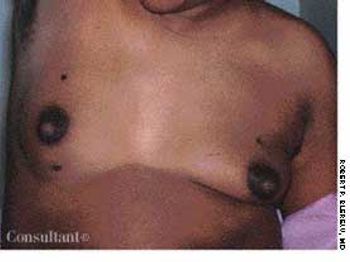
These are the breasts of a healthy 35-year-old woman as seen during a postpartum examination following delivery of twins. She had two supernumerary nipples on the right-one above and one below the normal nipple-and one supernumerary nipple on the left, superior to the normal nipple.

A 67-year-old man was concerned that the peeling lesion near his eyebrow was cancer.
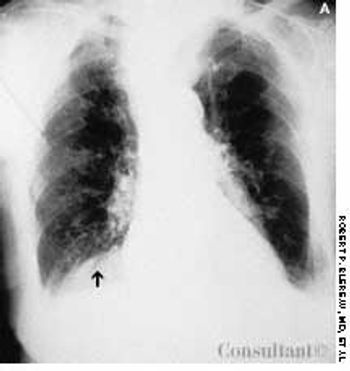
A 95-year-old woman was brought to the emergency department with hemoptysis. Erect posterior-anterior (A) and lateral (B) chest films showed a density at the base of the right lung posteriorly. A CT scan (C) revealed that the mass was the right kidney above the diaphragm and adjacent to the heart. The kidney had migrated through a foramen of Bochdalek.
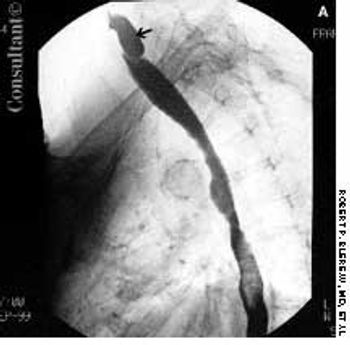
For 2 months, food particles had been regurgitating into a 72-year-old woman's throat after meals. Barium esophagography revealed a Zenker, or pharyngoesophageal, diverticulum.
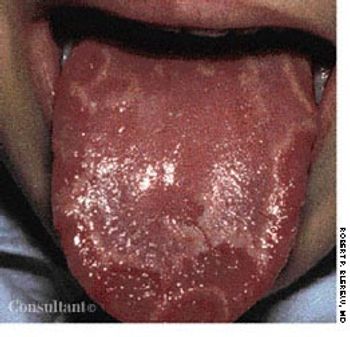
The smooth areas in the typical "mapping" of geographic tongue, shown here, represent flattened or denuded filiform papillae.
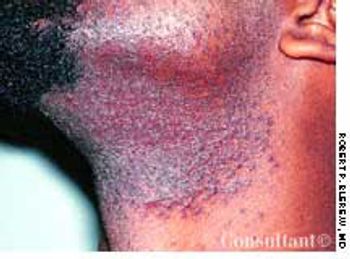
The rash on the neck of this 24-year-old man first appeared when he began to shave as a teenager. Pseudofolliculitis barbae affects 50% to 75% of black persons and 3% to 5% of white persons who shave.
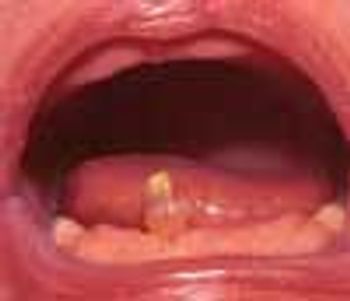
This newborn came into the world with a right lower canine tooth. Natal (predeciduous) teeth are present at birth, whereas neonatal teeth erupt within 30 days of birth. Both natal and neonatal teeth are generally primary teeth; they may erupt as a result of vertical displacement of tooth follicles.
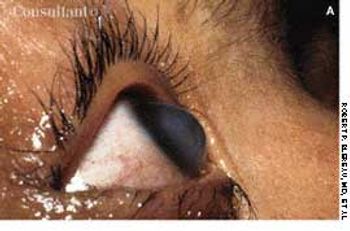
This 20-year-old woman with Down syndrome has bilateral keratoconus, a common, noninflammatory, paracentral corneal ectasia that is occasionally hereditary. Symptoms vary from none to severely blurred vision. Opacity of this patient's right cornea developed after her eye had teared excessively for 1 day, during which time she continually rubbed it.
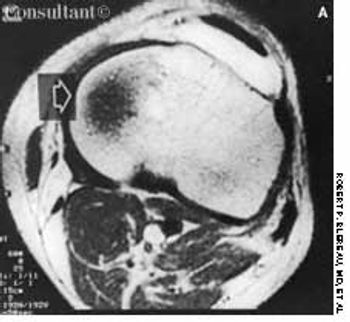
A 91-cm (3-ft) fall into a bilge sparked significant pain in the left knee of a 41-year-old man who landed on his left leg. Three days later, physicians found minimal effusion in the knee and medial collateral ligament tenderness.
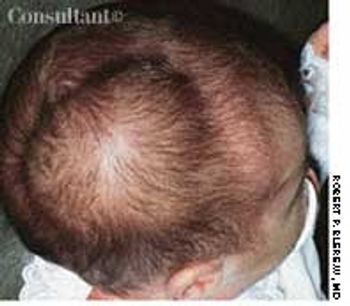
A right parietal cephalhematoma was first noted on this 2-week-old girl 2 days after her birth. Robert P. Blereau, MD of Morgan City, La, explains that a cephalhematoma is caused by bleeding under the outer periosteum of a newborn's skull bone, usually the parietal bone, and becomes evident as a swelling by day 2 or 3 after delivery. The swelling is confined to the involved bone and, therefore, does not go past the suture lines or the midline of the skull.
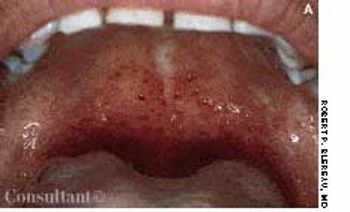
The variable appearance of palatal petechiae is demonstrated by these two cases, presented by Robert P. Blereau, MD of Morgan City, La. The petechiae appear as discrete pinhead lesions in a 10-year-old boy, whereas they are manifested as minute hemorrhagic areas in a 30-year-old woman.

The mother of a 5-year-old girl who was frightened by the appearance of a flat 'freckle' in her daughter's eye was reassured by the diagnosis of a benign conjunctival nevus.

Sudden pain and a pulsatile swelling of the right upper medial thigh concerned an 80-year-old woman. Coronary angioplasty had been performed through this site 5 weeks earlier.

The left hand of a 45-year-old man was affected with the characteristic intact bullae and dried, crusted, ruptured bullae of bullous impetigo.
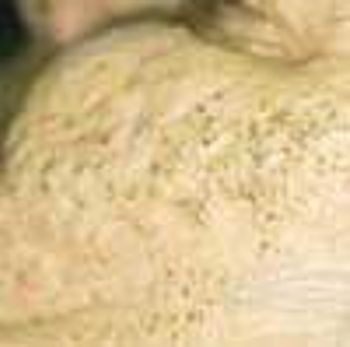
Basal cell carcinomas, the most common form of skin malignancy, are slow growing and rarely metastasize. They are seen most frequently in men over age 50, and more than 90% occur on sun-exposed areas of the head and neck. Cure rates approach 100%.
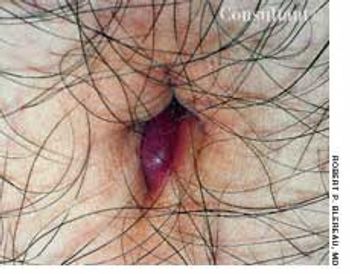
An obese 17-year-old boy sought treatment of an apparent abscess of the umbilicus. Hot soaks, black salve, and oral cephalexin were prescribed. Although there was some drainage, the lesion persisted and the patient returned for further evaluation.
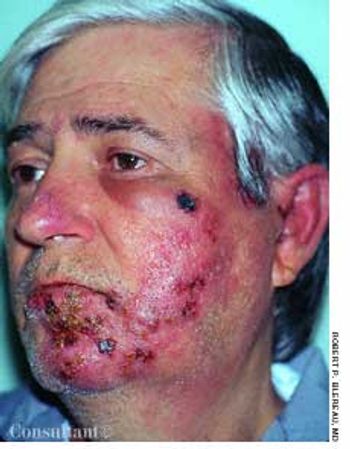
Redness and swelling of the left cheek, chin, and ear bothered a 51-year-old man. The initial diagnosis was cellulitis and/or allergic dermatitis; oral amoxicillin/clavulanate, 500 mg tid, and a low- to medium-potency corticosteroid cream, alclometasone, were prescribed. Within 1 to 2 days, pimples emerged in the reddened areas and rapidly crusted.